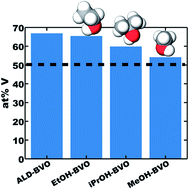Surface functionalized atomic layer deposition of bismuth vanadate for single-phase scheelite†
Abstract
Monoclinic bismuth vanadate is one of the most promising oxide photoanodes for solar – assisted water splitting. To date, the atomic layer deposition of bismuth vanadates has relied on the catalytic codeposition of BiPh3 with VTIP to produce vanadium-rich compounds that undergo spinodal decomposition to multiphase mixtures upon crystallization. A surface functionalization (SF) step of ROH/VTIP/H2O was developed to inhibit V2O5 deposition for adjustable Bi : V stoichiometry. Ethanol, 2-propanol, and methanol were each found to inhibit V2O5 deposition, in order of increasing effect. Applying this SF step with ternary Bi–V–O depositions (ROH/VTIP/H2O/BiPh3/H2O) enabled composition tuning. The use of methanol enabled 45.9 : 54.1 Bi : V atomic ratio as-deposited, and was crystallizable to phase-pure scheelite, depending on the thickness. The resulting films were applied towards photo-assisted water splitting with a hole-scavenging sulfite where films up to 60 nm thick were free from apparent charge transport limitations. The optoelectronic properties were markedly improved by a novel photoelectrochemical activation step.



 Please wait while we load your content...
Please wait while we load your content...